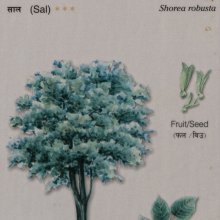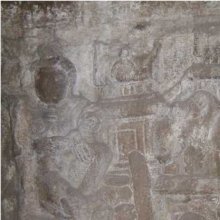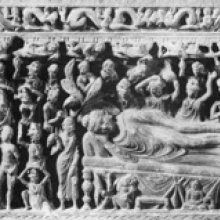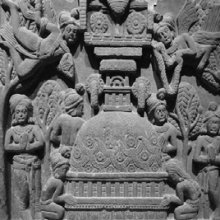Shala, Sālā, Sāla, Śala, Śālā, Śāla, Sala: 45 definitions
Introduction:
Shala means something in Buddhism, Pali, Hinduism, Sanskrit, Jainism, Prakrit, the history of ancient India, Marathi, Hindi, biology. If you want to know the exact meaning, history, etymology or English translation of this term then check out the descriptions on this page. Add your comment or reference to a book if you want to contribute to this summary article.
Shala has 45 English definitions available.
The Sanskrit terms Śala and Śālā and Śāla can be transliterated into English as Sala or Shala, using the IAST transliteration scheme (?).
Alternative spellings of this word include Shaal.
Images (photo gallery)
(+1 more images available)
Languages of India and abroad
Sanskrit dictionary
[Deutsch Wörterbuch]
Source: Cologne Digital Sanskrit Dictionaries: Böhtlingk and Roth Grosses Petersburger WörterbuchŚala (शल):—
--- OR ---
Śāla (शाल):—1. (von śālā)
1) adj. in der Hütte u. s. w. befindlich [The Śatapathabrāhmaṇa 1, 1, 2, 5.] te devāścakramacarañchālamasurā āsan so v. a. sassen zu Hause [6, 8, 1, 1.] —
2) m. a) Vatica robusta, ein hoher stattlicher Baum (der zum Häuserbau gebraucht wird) [Amarakoṣa.2,4,2,25.] [Trikāṇḍaśeṣa.2,4,21.3,3,407. 410.] [Hemacandra’s Abhidhānacintāmaṇi 1138.] [Anekārthasaṃgraha 2,515.] [Medinīkoṣa l. 54.] [Hārāvalī 182.] [Halāyudha 2,40.5,26.] [ŚĀŚVATA] bei [Mallinātha] zu [Kirātārjunīya 10,34. 14,34.] [Manu’s Gesetzbuch 8,246.] [Mahābhārata 1,5927. 7716.3,1400. 2404. 15703. 15940.4,513.5,864.8,4345.9,3239. 13,635. 14,2521.] [Harivaṃśa 9002.] [Rāmāyaṇa 2,97,12 (106,8 Gorresio). 98,28. 100,18.3,17,9. 35,77.4,1,12. 19,22.5,39,25.6,17,7.7,23,1,58.] [Suśruta.1,46,14. 145,8. 12.2,110,13. 131,12. 468,18.] [Kirātārjunīya 10,34. 14,34.] [Varāhamihira’s Bṛhajjātaka S. 29,2. 53,87. 59,6. 79,2. 13. 16. 85,7.] [Journ. of the Am. Or. S. 6,588.] [Śatruṃjayamāhātmya 2,6.] [Brahmapurāṇa] in [Lassen’s Anthologie (III) 51,19.] [PAÑCAR.1,7,23.] [VĀSAVAD. 134,3.] [Oxforder Handschriften 17,a, No. 63, Śloka 4. 257], a, [Nalopākhyāna 3.] vana (vgl. bhadrasālavana) [Mahābhārata 1, 4476. 3, 945. 8, 2305.] [Rāmāyaṇa 2, 71, 16 (73, 14 Gorresio).] skandha [Mahābhārata 2, 826.] [Rāmāyaṇa 2, 96, 13 (105, 12 Gorresio).] stambha [Mahābhārata 1, 3066. 2, 825. 5, 5856.] niryāsa [Ratnamālā 274.] [Suśruta 2, 495, 18. 501, 16.] [Raghuvaṃśa 1, 38.] pota [Mahābhārata 1, 5942. 3, 11690. 7, 2504.] prāṃśu [Raghuvaṃśa 1, 13.] saṃkāśamūrum [Mahābhārata 1, 3867.] puṣpanibhā (= raktapītāḥ [Nīlakaṇṭha]) hayāḥ [7, 980.] Wird häufig (in den Bomb. Ausgg. jedoch nur ausnahmsweise) sāla geschrieben. — b) Baum überh. [Amarakoṣa 2, 4, 1, 5.] [Hemacandra’s Abhidhānacintāmaṇi 1114.] [Hemacandra’s Anekārthasaṃgraha] [Medinīkoṣa] [Halāyudha 2, 22.] [ŚĀŚVATA] bei [Mallinātha] zu [Kirātārjunīya 14, 34.] kalpa = kalpataru Inschr. in [Journ. of the Am. Or. S. 6, 505,] [Śloka 16.] Auch sāla geschrieben. — c) Einfriedigung, Wall (hierzu mag die Vatica robusta verwendet worden sein) [Amarakoṣa 2, 2, 3.] [Trikāṇḍaśeṣa 3, 3, 410.] [Hemacandra’s Abhidhānacintāmaṇi 980.] [Hemacandra’s Anekārthasaṃgraha] [Medinīkoṣa] [Halāyudha 2, 133.] [ŚĀŚVATA a. a. O.] sumahāśālamekhalā (purī) [Rāmāyaṇa 1, 5, 12.] mahāśālāvṛtā (purī) [Rāmāyaṇa Gorresio 1, 5, 5.] paryasta adj. [Raghuvaṃśa 16, 11.] bṛhanmaṇiśilā adj. [Kumārasaṃbhava 6, 38.] [Daśakumāracarita 94, 1.] śṛṅga n. (= prācīrāgra [Śabdakalpadruma]) the upper part or coping of a wall [WILSON] nach [ŚABDĀRTHAK.] Auch sāla geschrieben. — Vgl. pīta, bṛhacchāla, śukla .
--- OR ---
Śāla (शाल):—2. m.
1) ein best. Fisch [Amarakoṣa 1, 2, 3, 19.] [Trikāṇḍaśeṣa 1, 2, 20. 3, 3, 407.] [Hemacandra’s Anekārthasaṃgraha 2, 511.] [Medinīkoṣa l. 50. fg.] [Halāyudha 3, 37.] [VĀSAVAD. 134, 3.] —
2) Nomen proprium eines Sohnes des Vṛka [Bhāgavatapurāṇa 9, 24, 42.] = śālivāhana [Trikāṇḍaśeṣa 3, 3, 407.] [Hemacandra’s Anekārthasaṃgraha] [VIŚVA im Śabdakalpadruma]
--- OR ---
Śāla (शाल):—3. m. = śala gaṇa jvalādi zu [Pāṇini’s acht Bücher 3, 1, 140.] m. n. (sāla) gaṇa ardharcādi zu [Pāṇini’s acht Bücher.2,4,31.] [Siddhāntakaumudī 250,b,8.]
--- OR ---
Śālā (शाला):—(von 3. śar) f. [UJJVAL.] zu [Uṇādisūtra 1, 117.]
1) Hütte, Haus, Gemach; Stall [Amarakoṣa 2, 2, 5. 3, 6, 3, 27.] [Trikāṇḍaśeṣa 3, 3, 406.] [Hemacandra’s Abhidhānacintāmaṇi 990.] [Anekārthasaṃgraha 2, 511.] [Medinīkoṣa l. 50.] [Halāyudha 2, 136.] grāma = śālāsamudāya [Patañjali] (s. u. grāma
1) in den Nachträgen). [Atharvavedasaṃhitā 3, 12, 1. fgg. 5, 31, 5. 6, 106, 3. 8, 6, 10. 9, 3, 1. 13. 15. 14, 1, 63.] [Taittirīyabrāhmaṇa 1, 2, 3, 1.] [The Śatapathabrāhmaṇa 3, 1, 1, 6. 11. 2, 4, 15. 6, 2, 20. 4, 5, 7, 4.] [Kauśika’s Sūtra zum Atuarvaveda 93.] karman [Pāraskara’s Gṛhyasūtrāṇi 3, 4.] stambha [Kātyāyana’s Śrautasūtrāṇi 7, 1, 36.] tṛṇa [Kauśika’s Sūtra zum Atuarvaveda 18. 80.] nava [23.] go [24.] [KṚṢIS. 7, 14.] mahatī śubhā Haus [Rāmāyaṇa 5, 13, 10. 29.] mātāmaha [Kathāsaritsāgara 74, 62] (st. dessen gṛha 91). bhārgavaveśmani Gemach [Mahābhārata 1, 391. 4, 510. fg.] [Varāhamihira’s Bṛhajjātaka S. 53, 11. 17. fgg.] [Bhāgavatapurāṇa 8, 9, 16.] = parṇa [Rāmāyaṇa 2, 56, 18. 21. 31. 100, 5. 111, 14.] Stall [Mahābhārata 3, 2857. 13, 4316.] vāhanānām [14, 2530.] gajavājinām [Rāmāyaṇa 2, 91, 32 (100, 30 Gorresio).] [Raghuvaṃśa 16, 41.] [Spr. 2730.] [Kathāsaritsāgara 52, 118. 68, 55.] śṛṅgāra Gemach Inschr. in [Journ. of the Am. Or. S. 6, 506,] [Śloka 24.] karmāntāṅgāra [Mārkāṇḍeyapurāṇa 35, 14.] kulāla Werkstatt [JĀBĀLOP.] in [Weber’s Indische Studien 2, 77.] aśvacalana (ed. Bomb. aśvaśālā Pferdestall) [Pañcatantra 252, 21.] Am Ende eines comp. śālā f. und śāla n. [Pāṇini’s acht Bücher 2, 4, 25. 6, 2, 123.] [Amarakoṣa 3, 6, 6, 40.] —
2) Ast [Amarakoṣa 2, 4, 1, 11.] [Trikāṇḍaśeṣa] [Hemacandra’s Abhidhānacintāmaṇi 1119.] [Hemacandra’s Anekārthasaṃgraha] [Medinīkoṣa] [Halāyudha 2, 27]; vgl. [Mārkāṇḍeyapurāṇa 49, 54.] —
3) ein best. Metrum: a. b. d. ˘ ¯ ˘ ¯ ¯ ˘ ˘ ¯ ˘ ¯ ¯ c. ¯ ¯ ˘ ¯ ¯ ˘ ˘ ¯ ˘ ¯ ¯ [Journ. of the Am. Or. S. 6, 514.] — Vgl. agni, aśva, ārogya ( [Rājataraṅgiṇī 3, 461]), eka, gāndharva, giri, go, gomi, catuḥ, candra, citra, ṭaṅkaka, tantu, turaṃgama, tri, dākṣiṇa, dyūta, dvi, dhanuḥ, dharma, nartana, nāpita, niḥsāla, nṛtyaśālā, pakṣi, paṇya, patnī (n. auch [Kauśika’s Sūtra zum Atuarvaveda 77] in [Weber’s Indische Studien 5, 391]), parṇa, pāka, pāṭha, pānīya, puṇya, pūpa, peli, prācīna, bahu, brahma, bhakta, bhāṇḍa, bhāṇḍi, mahāśva, yajña, yajñiya, yāna, raṅga, ratha, vatsa, vahni, vāji, vāraṇa, śakra, śilpa, śulka, saṃgīta, sattra, sūda, hasti.
--- OR ---
Sala (सल):—
1) m. Hand [Hemacandra’s Abhidhānacintāmaṇi 123.] —
2) n. = salila Wasser [Bharata] zu [Amarakoṣa 1, 2, 3, 3] nach [Śabdakalpadruma] — Vgl. salais .
--- OR ---
Sāla (साल):—m. Nomen proprium eines Fürsten [Rājataraṅgiṇī 7, 218.] — Vgl. 1. śāla .
Sanskrit, also spelled संस्कृतम् (saṃskṛtam), is an ancient language of India commonly seen as the grandmother of the Indo-European language family (even English!). Closely allied with Prakrit and Pali, Sanskrit is more exhaustive in both grammar and terms and has the most extensive collection of literature in the world, greatly surpassing its sister-languages Greek and Latin.
See also (Relevant definitions)
Starts with (+195): Saladi, Salai, Salaka, Salakatankati, Salala, Salana, Salanga, Salani, Salapushpa, Salarasa, Salashringa, Salata, Salati, Salatu, Salatuka, Salava, Salavahana, Salavaka, Salavalaya, Salavana.
Ends with (+348): Abhishekashala, Acashala, Agnishala, Agra-shala, Ahavadharmakushala, Akaushala, Akhandishala, Akhyanakushala, Akka-shala, Akshakushala, Akshala, Akshashala, Akusala, Alapakushala, Amshala, Anga-shala, Anka-shala, Annashala, Anushala, Apakshala.
Full-text (+1451): Shalam, Shalaveshta, Dashashala, Shalabhanjika, Salavrika, Shalaniryasa, Sudashala, Panyashala, Hastishala, Salarasa, Padashala, Satasala, Shalaja, Shilpashala, Tankashala, Pakashala, Salakari, Ashvashala, Pancasala, Upashalam.
Relevant text
Search found 152 books and stories containing Shala, Sālā, Sāla, Śala, Śālā, Śāla, Sala, Śāḷa, Śāḷā, Salā, Saḷa, Saḷā, Sāḷa, Sāḷā, Śaḷa; (plurals include: Shalas, Sālās, Sālas, Śalas, Śālās, Śālas, Salas, Śāḷas, Śāḷās, Salās, Saḷas, Saḷās, Sāḷas, Sāḷās, Śaḷas). You can also click to the full overview containing English textual excerpts. Below are direct links for the most relevant articles:
Garga Samhita (English) (by Danavir Goswami)
Verse 1.6.17 < [Chapter 6 - Description of Kaṃsa’s Strength]
Verse 1.6.23 < [Chapter 6 - Description of Kaṃsa’s Strength]
Verse 5.7.12 < [Chapter 7 - The Killing of Kuvalayāpīḍa]
Kashyapa Shilpa-shastra (study) (by K. Vidyuta)
1-2. Etymology and Definition of Prākāra < [Chapter 3 - Prākāra Lakṣaṇa]
5. Measurement for the Storeys of the Gopuras < [Chapter 5 - Gopura Lakṣaṇa]
The Matsya Purana (critical study) (by Kushal Kalita)
Part 2.1 - Measurement of Buildings < [Chapter 7 - Art and Architecture in the Matsyapurāṇa]
Part 1a - Note on Architecture (vāstu) < [Chapter 7 - Art and Architecture in the Matsyapurāṇa]
Vastu-shastra (3): House Architecture (by D. N. Shukla)
Vastu-shastra (5): Temple Architecture (by D. N. Shukla)
Temples of Mayūrbhañja < [Chapter 12 - History of Hindu Temples (Prāsādas and Vimānas)]
Guhārāja Cave-Temples < [Chapter 12 - History of Hindu Temples (Prāsādas and Vimānas)]
Related products










